Consulting Report: Impression Management and Client Relationships
VerifiedAdded on 2022/11/13
|11
|3230
|1
Report
AI Summary
This report reviews an academic paper on management consulting, exploring the concept of impression management and its crucial role in securing and maintaining consultant-client relationships. The analysis delves into the intangible nature of professional services, emphasizing the importance of perception, interaction, and effective communication. The report highlights the significance of client experience, relationship marketing, and the need for consultants to manage impressions to build trust and credibility. The paper discusses the techniques of impression management, including acclamation, conformity, association, and flattery, while acknowledging the importance of accurate and transparent communication. It also examines the role of perception, individual differences, and the impact of customer characteristics on the consulting process. Furthermore, the report emphasizes the importance of qualitative research and effective communication processes in securing contracts and building lasting relationships. Finally, it underscores the significance of positive perception and impression management in securing consulting projects.
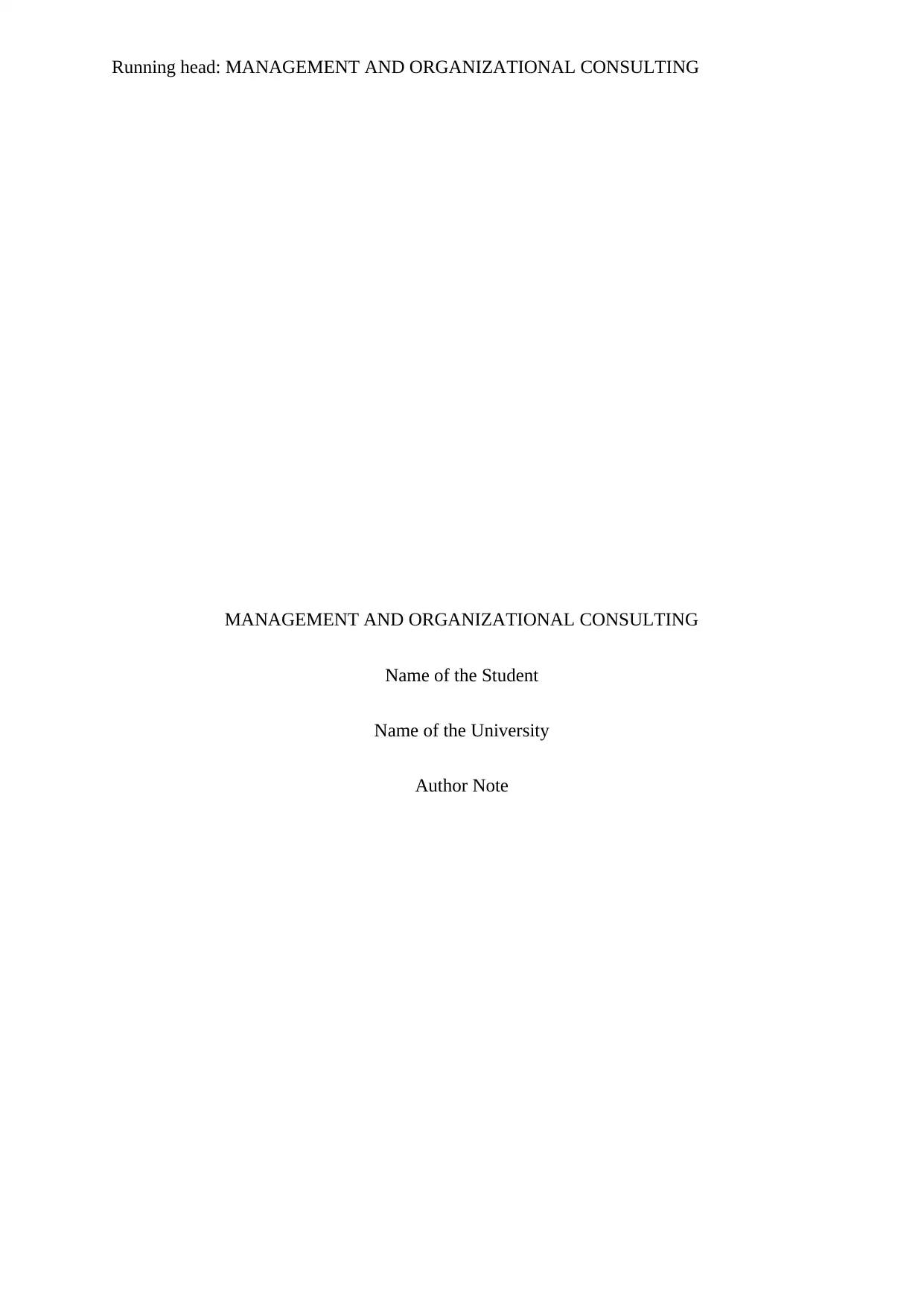
Running head: MANAGEMENT AND ORGANIZATIONAL CONSULTING
MANAGEMENT AND ORGANIZATIONAL CONSULTING
Name of the Student
Name of the University
Author Note
MANAGEMENT AND ORGANIZATIONAL CONSULTING
Name of the Student
Name of the University
Author Note
Paraphrase This Document
Need a fresh take? Get an instant paraphrase of this document with our AI Paraphraser
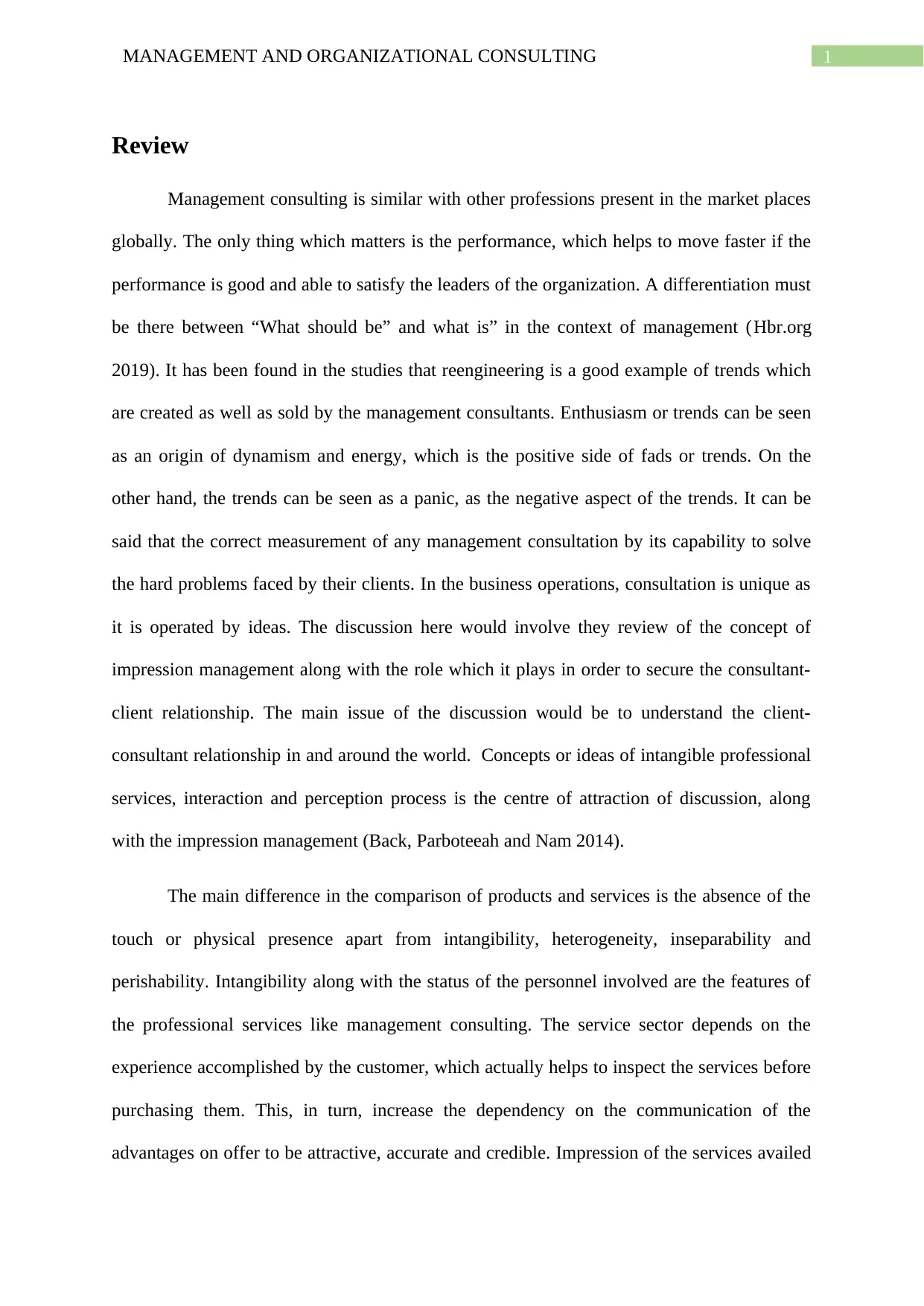
1MANAGEMENT AND ORGANIZATIONAL CONSULTING
Review
Management consulting is similar with other professions present in the market places
globally. The only thing which matters is the performance, which helps to move faster if the
performance is good and able to satisfy the leaders of the organization. A differentiation must
be there between “What should be” and what is” in the context of management (Hbr.org
2019). It has been found in the studies that reengineering is a good example of trends which
are created as well as sold by the management consultants. Enthusiasm or trends can be seen
as an origin of dynamism and energy, which is the positive side of fads or trends. On the
other hand, the trends can be seen as a panic, as the negative aspect of the trends. It can be
said that the correct measurement of any management consultation by its capability to solve
the hard problems faced by their clients. In the business operations, consultation is unique as
it is operated by ideas. The discussion here would involve they review of the concept of
impression management along with the role which it plays in order to secure the consultant-
client relationship. The main issue of the discussion would be to understand the client-
consultant relationship in and around the world. Concepts or ideas of intangible professional
services, interaction and perception process is the centre of attraction of discussion, along
with the impression management (Back, Parboteeah and Nam 2014).
The main difference in the comparison of products and services is the absence of the
touch or physical presence apart from intangibility, heterogeneity, inseparability and
perishability. Intangibility along with the status of the personnel involved are the features of
the professional services like management consulting. The service sector depends on the
experience accomplished by the customer, which actually helps to inspect the services before
purchasing them. This, in turn, increase the dependency on the communication of the
advantages on offer to be attractive, accurate and credible. Impression of the services availed
Review
Management consulting is similar with other professions present in the market places
globally. The only thing which matters is the performance, which helps to move faster if the
performance is good and able to satisfy the leaders of the organization. A differentiation must
be there between “What should be” and what is” in the context of management (Hbr.org
2019). It has been found in the studies that reengineering is a good example of trends which
are created as well as sold by the management consultants. Enthusiasm or trends can be seen
as an origin of dynamism and energy, which is the positive side of fads or trends. On the
other hand, the trends can be seen as a panic, as the negative aspect of the trends. It can be
said that the correct measurement of any management consultation by its capability to solve
the hard problems faced by their clients. In the business operations, consultation is unique as
it is operated by ideas. The discussion here would involve they review of the concept of
impression management along with the role which it plays in order to secure the consultant-
client relationship. The main issue of the discussion would be to understand the client-
consultant relationship in and around the world. Concepts or ideas of intangible professional
services, interaction and perception process is the centre of attraction of discussion, along
with the impression management (Back, Parboteeah and Nam 2014).
The main difference in the comparison of products and services is the absence of the
touch or physical presence apart from intangibility, heterogeneity, inseparability and
perishability. Intangibility along with the status of the personnel involved are the features of
the professional services like management consulting. The service sector depends on the
experience accomplished by the customer, which actually helps to inspect the services before
purchasing them. This, in turn, increase the dependency on the communication of the
advantages on offer to be attractive, accurate and credible. Impression of the services availed

2MANAGEMENT AND ORGANIZATIONAL CONSULTING
by the accuracy and present information available to the potential customers. Production of
accurate comparisons also creates difficulty in comparison of two similar kind of services,
due to the absence of unbiased material. Though, access of internet has helped to a certain
extend in this context, which has increased the comparisons and decreased the ineffectiveness
of traditional comparisons involving prices. It has been also found in the researches and
studies that there is importance in the repetitive businesses from the old clients in the service
provider organizations, and it also focused or prioritized on retention of those clients rather
than acquisition of new clients. The service provider companies need to spend financial as
well as marketing resources along with time in order to secure fresh customers. On the other
hand, less resources are required in case of old customers, who possess a healthy relationship
with the service provider companies. All this has been studied by the researchers in the
context of relationship marketing. The first and foremost criteria related with the service
companies is to develop and maintain a healthy and good relationship with the customers. It
has been studied that earning profit is less important than sustaining the old customers in the
organizations related to the service industry.
Consultancy is a part of impression management, which can be termed as the attempt
to convince the customers on their quality and value. The processes or ways through which
the control is made over the impression of others is termed as impression management, and
consultancy is termed as a professional helper. It has been stated by the researchers that there
is existence of impression management in order to secure the consultant contract of the
customers and tries to evaluate the nature of impression management in order to understand
the relationship between consultants and clients. Career advancement is the primary
requirement to achieve the goal of an employer in the service provider organization.
Impression management is about the influence of the service provider organizations on the
customers or the people as a whole about the image which they possess on the companies.
by the accuracy and present information available to the potential customers. Production of
accurate comparisons also creates difficulty in comparison of two similar kind of services,
due to the absence of unbiased material. Though, access of internet has helped to a certain
extend in this context, which has increased the comparisons and decreased the ineffectiveness
of traditional comparisons involving prices. It has been also found in the researches and
studies that there is importance in the repetitive businesses from the old clients in the service
provider organizations, and it also focused or prioritized on retention of those clients rather
than acquisition of new clients. The service provider companies need to spend financial as
well as marketing resources along with time in order to secure fresh customers. On the other
hand, less resources are required in case of old customers, who possess a healthy relationship
with the service provider companies. All this has been studied by the researchers in the
context of relationship marketing. The first and foremost criteria related with the service
companies is to develop and maintain a healthy and good relationship with the customers. It
has been studied that earning profit is less important than sustaining the old customers in the
organizations related to the service industry.
Consultancy is a part of impression management, which can be termed as the attempt
to convince the customers on their quality and value. The processes or ways through which
the control is made over the impression of others is termed as impression management, and
consultancy is termed as a professional helper. It has been stated by the researchers that there
is existence of impression management in order to secure the consultant contract of the
customers and tries to evaluate the nature of impression management in order to understand
the relationship between consultants and clients. Career advancement is the primary
requirement to achieve the goal of an employer in the service provider organization.
Impression management is about the influence of the service provider organizations on the
customers or the people as a whole about the image which they possess on the companies.
⊘ This is a preview!⊘
Do you want full access?
Subscribe today to unlock all pages.

Trusted by 1+ million students worldwide
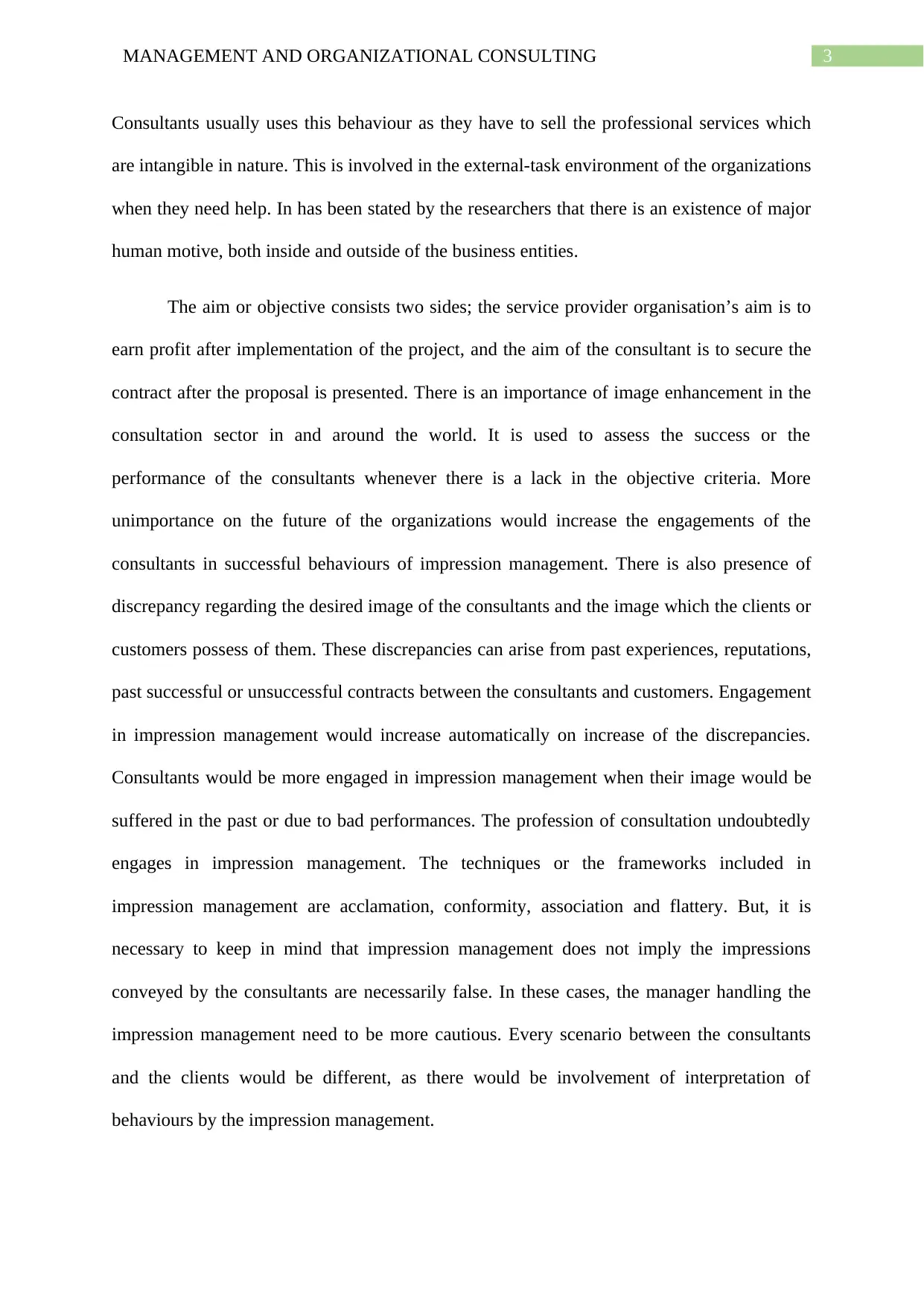
3MANAGEMENT AND ORGANIZATIONAL CONSULTING
Consultants usually uses this behaviour as they have to sell the professional services which
are intangible in nature. This is involved in the external-task environment of the organizations
when they need help. In has been stated by the researchers that there is an existence of major
human motive, both inside and outside of the business entities.
The aim or objective consists two sides; the service provider organisation’s aim is to
earn profit after implementation of the project, and the aim of the consultant is to secure the
contract after the proposal is presented. There is an importance of image enhancement in the
consultation sector in and around the world. It is used to assess the success or the
performance of the consultants whenever there is a lack in the objective criteria. More
unimportance on the future of the organizations would increase the engagements of the
consultants in successful behaviours of impression management. There is also presence of
discrepancy regarding the desired image of the consultants and the image which the clients or
customers possess of them. These discrepancies can arise from past experiences, reputations,
past successful or unsuccessful contracts between the consultants and customers. Engagement
in impression management would increase automatically on increase of the discrepancies.
Consultants would be more engaged in impression management when their image would be
suffered in the past or due to bad performances. The profession of consultation undoubtedly
engages in impression management. The techniques or the frameworks included in
impression management are acclamation, conformity, association and flattery. But, it is
necessary to keep in mind that impression management does not imply the impressions
conveyed by the consultants are necessarily false. In these cases, the manager handling the
impression management need to be more cautious. Every scenario between the consultants
and the clients would be different, as there would be involvement of interpretation of
behaviours by the impression management.
Consultants usually uses this behaviour as they have to sell the professional services which
are intangible in nature. This is involved in the external-task environment of the organizations
when they need help. In has been stated by the researchers that there is an existence of major
human motive, both inside and outside of the business entities.
The aim or objective consists two sides; the service provider organisation’s aim is to
earn profit after implementation of the project, and the aim of the consultant is to secure the
contract after the proposal is presented. There is an importance of image enhancement in the
consultation sector in and around the world. It is used to assess the success or the
performance of the consultants whenever there is a lack in the objective criteria. More
unimportance on the future of the organizations would increase the engagements of the
consultants in successful behaviours of impression management. There is also presence of
discrepancy regarding the desired image of the consultants and the image which the clients or
customers possess of them. These discrepancies can arise from past experiences, reputations,
past successful or unsuccessful contracts between the consultants and customers. Engagement
in impression management would increase automatically on increase of the discrepancies.
Consultants would be more engaged in impression management when their image would be
suffered in the past or due to bad performances. The profession of consultation undoubtedly
engages in impression management. The techniques or the frameworks included in
impression management are acclamation, conformity, association and flattery. But, it is
necessary to keep in mind that impression management does not imply the impressions
conveyed by the consultants are necessarily false. In these cases, the manager handling the
impression management need to be more cautious. Every scenario between the consultants
and the clients would be different, as there would be involvement of interpretation of
behaviours by the impression management.
Paraphrase This Document
Need a fresh take? Get an instant paraphrase of this document with our AI Paraphraser
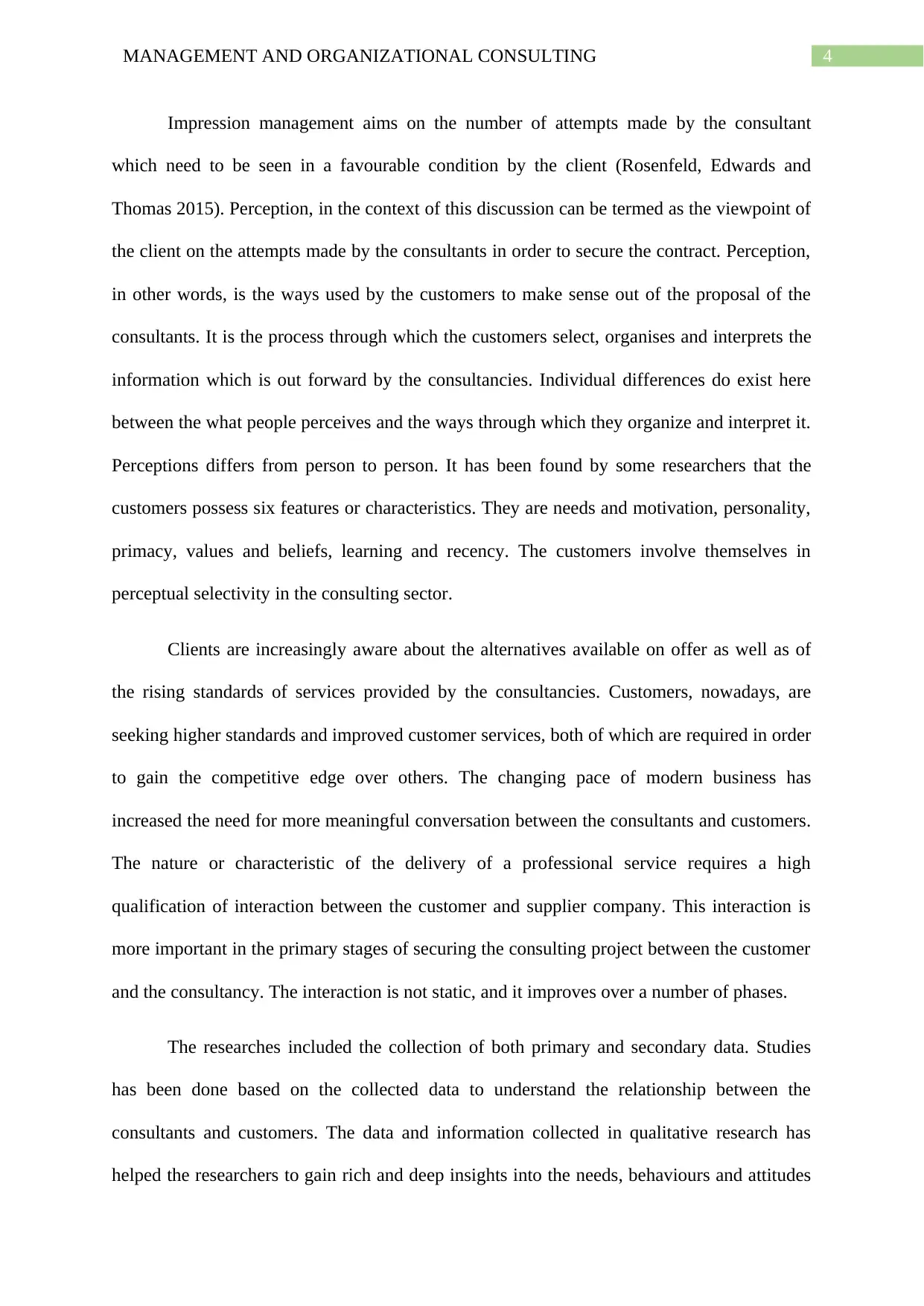
4MANAGEMENT AND ORGANIZATIONAL CONSULTING
Impression management aims on the number of attempts made by the consultant
which need to be seen in a favourable condition by the client (Rosenfeld, Edwards and
Thomas 2015). Perception, in the context of this discussion can be termed as the viewpoint of
the client on the attempts made by the consultants in order to secure the contract. Perception,
in other words, is the ways used by the customers to make sense out of the proposal of the
consultants. It is the process through which the customers select, organises and interprets the
information which is out forward by the consultancies. Individual differences do exist here
between the what people perceives and the ways through which they organize and interpret it.
Perceptions differs from person to person. It has been found by some researchers that the
customers possess six features or characteristics. They are needs and motivation, personality,
primacy, values and beliefs, learning and recency. The customers involve themselves in
perceptual selectivity in the consulting sector.
Clients are increasingly aware about the alternatives available on offer as well as of
the rising standards of services provided by the consultancies. Customers, nowadays, are
seeking higher standards and improved customer services, both of which are required in order
to gain the competitive edge over others. The changing pace of modern business has
increased the need for more meaningful conversation between the consultants and customers.
The nature or characteristic of the delivery of a professional service requires a high
qualification of interaction between the customer and supplier company. This interaction is
more important in the primary stages of securing the consulting project between the customer
and the consultancy. The interaction is not static, and it improves over a number of phases.
The researches included the collection of both primary and secondary data. Studies
has been done based on the collected data to understand the relationship between the
consultants and customers. The data and information collected in qualitative research has
helped the researchers to gain rich and deep insights into the needs, behaviours and attitudes
Impression management aims on the number of attempts made by the consultant
which need to be seen in a favourable condition by the client (Rosenfeld, Edwards and
Thomas 2015). Perception, in the context of this discussion can be termed as the viewpoint of
the client on the attempts made by the consultants in order to secure the contract. Perception,
in other words, is the ways used by the customers to make sense out of the proposal of the
consultants. It is the process through which the customers select, organises and interprets the
information which is out forward by the consultancies. Individual differences do exist here
between the what people perceives and the ways through which they organize and interpret it.
Perceptions differs from person to person. It has been found by some researchers that the
customers possess six features or characteristics. They are needs and motivation, personality,
primacy, values and beliefs, learning and recency. The customers involve themselves in
perceptual selectivity in the consulting sector.
Clients are increasingly aware about the alternatives available on offer as well as of
the rising standards of services provided by the consultancies. Customers, nowadays, are
seeking higher standards and improved customer services, both of which are required in order
to gain the competitive edge over others. The changing pace of modern business has
increased the need for more meaningful conversation between the consultants and customers.
The nature or characteristic of the delivery of a professional service requires a high
qualification of interaction between the customer and supplier company. This interaction is
more important in the primary stages of securing the consulting project between the customer
and the consultancy. The interaction is not static, and it improves over a number of phases.
The researches included the collection of both primary and secondary data. Studies
has been done based on the collected data to understand the relationship between the
consultants and customers. The data and information collected in qualitative research has
helped the researchers to gain rich and deep insights into the needs, behaviours and attitudes
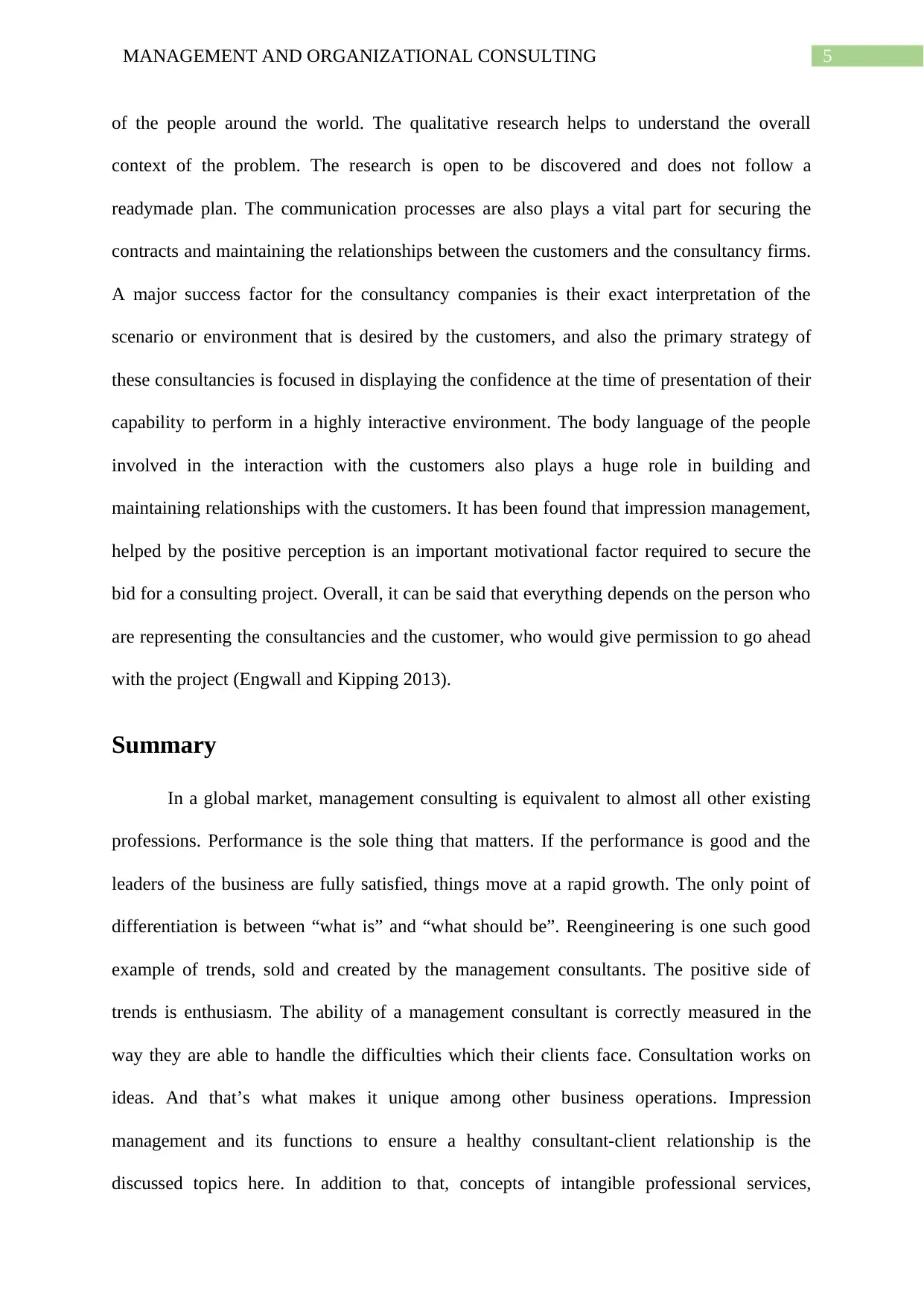
5MANAGEMENT AND ORGANIZATIONAL CONSULTING
of the people around the world. The qualitative research helps to understand the overall
context of the problem. The research is open to be discovered and does not follow a
readymade plan. The communication processes are also plays a vital part for securing the
contracts and maintaining the relationships between the customers and the consultancy firms.
A major success factor for the consultancy companies is their exact interpretation of the
scenario or environment that is desired by the customers, and also the primary strategy of
these consultancies is focused in displaying the confidence at the time of presentation of their
capability to perform in a highly interactive environment. The body language of the people
involved in the interaction with the customers also plays a huge role in building and
maintaining relationships with the customers. It has been found that impression management,
helped by the positive perception is an important motivational factor required to secure the
bid for a consulting project. Overall, it can be said that everything depends on the person who
are representing the consultancies and the customer, who would give permission to go ahead
with the project (Engwall and Kipping 2013).
Summary
In a global market, management consulting is equivalent to almost all other existing
professions. Performance is the sole thing that matters. If the performance is good and the
leaders of the business are fully satisfied, things move at a rapid growth. The only point of
differentiation is between “what is” and “what should be”. Reengineering is one such good
example of trends, sold and created by the management consultants. The positive side of
trends is enthusiasm. The ability of a management consultant is correctly measured in the
way they are able to handle the difficulties which their clients face. Consultation works on
ideas. And that’s what makes it unique among other business operations. Impression
management and its functions to ensure a healthy consultant-client relationship is the
discussed topics here. In addition to that, concepts of intangible professional services,
of the people around the world. The qualitative research helps to understand the overall
context of the problem. The research is open to be discovered and does not follow a
readymade plan. The communication processes are also plays a vital part for securing the
contracts and maintaining the relationships between the customers and the consultancy firms.
A major success factor for the consultancy companies is their exact interpretation of the
scenario or environment that is desired by the customers, and also the primary strategy of
these consultancies is focused in displaying the confidence at the time of presentation of their
capability to perform in a highly interactive environment. The body language of the people
involved in the interaction with the customers also plays a huge role in building and
maintaining relationships with the customers. It has been found that impression management,
helped by the positive perception is an important motivational factor required to secure the
bid for a consulting project. Overall, it can be said that everything depends on the person who
are representing the consultancies and the customer, who would give permission to go ahead
with the project (Engwall and Kipping 2013).
Summary
In a global market, management consulting is equivalent to almost all other existing
professions. Performance is the sole thing that matters. If the performance is good and the
leaders of the business are fully satisfied, things move at a rapid growth. The only point of
differentiation is between “what is” and “what should be”. Reengineering is one such good
example of trends, sold and created by the management consultants. The positive side of
trends is enthusiasm. The ability of a management consultant is correctly measured in the
way they are able to handle the difficulties which their clients face. Consultation works on
ideas. And that’s what makes it unique among other business operations. Impression
management and its functions to ensure a healthy consultant-client relationship is the
discussed topics here. In addition to that, concepts of intangible professional services,
⊘ This is a preview!⊘
Do you want full access?
Subscribe today to unlock all pages.

Trusted by 1+ million students worldwide
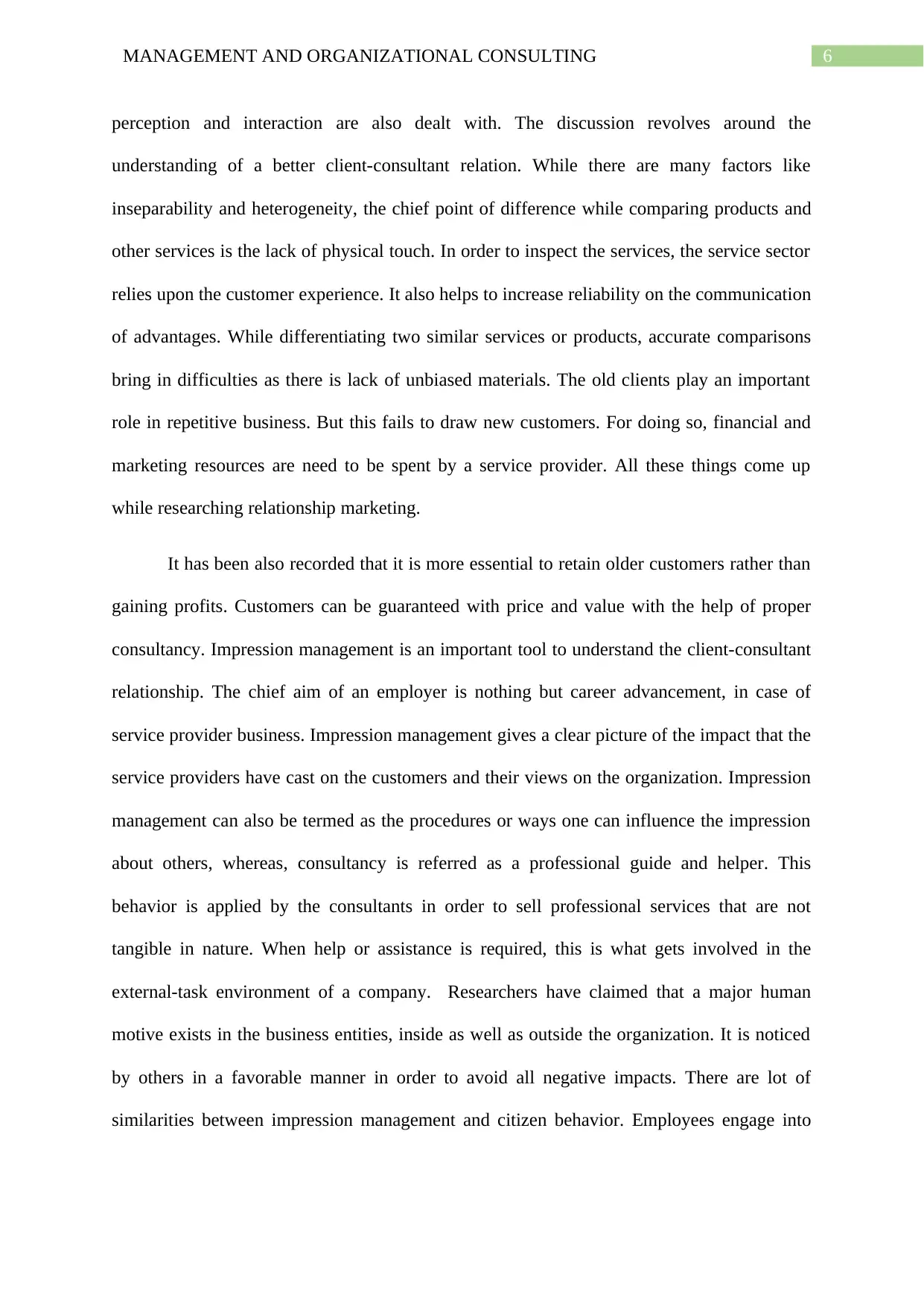
6MANAGEMENT AND ORGANIZATIONAL CONSULTING
perception and interaction are also dealt with. The discussion revolves around the
understanding of a better client-consultant relation. While there are many factors like
inseparability and heterogeneity, the chief point of difference while comparing products and
other services is the lack of physical touch. In order to inspect the services, the service sector
relies upon the customer experience. It also helps to increase reliability on the communication
of advantages. While differentiating two similar services or products, accurate comparisons
bring in difficulties as there is lack of unbiased materials. The old clients play an important
role in repetitive business. But this fails to draw new customers. For doing so, financial and
marketing resources are need to be spent by a service provider. All these things come up
while researching relationship marketing.
It has been also recorded that it is more essential to retain older customers rather than
gaining profits. Customers can be guaranteed with price and value with the help of proper
consultancy. Impression management is an important tool to understand the client-consultant
relationship. The chief aim of an employer is nothing but career advancement, in case of
service provider business. Impression management gives a clear picture of the impact that the
service providers have cast on the customers and their views on the organization. Impression
management can also be termed as the procedures or ways one can influence the impression
about others, whereas, consultancy is referred as a professional guide and helper. This
behavior is applied by the consultants in order to sell professional services that are not
tangible in nature. When help or assistance is required, this is what gets involved in the
external-task environment of a company. Researchers have claimed that a major human
motive exists in the business entities, inside as well as outside the organization. It is noticed
by others in a favorable manner in order to avoid all negative impacts. There are lot of
similarities between impression management and citizen behavior. Employees engage into
perception and interaction are also dealt with. The discussion revolves around the
understanding of a better client-consultant relation. While there are many factors like
inseparability and heterogeneity, the chief point of difference while comparing products and
other services is the lack of physical touch. In order to inspect the services, the service sector
relies upon the customer experience. It also helps to increase reliability on the communication
of advantages. While differentiating two similar services or products, accurate comparisons
bring in difficulties as there is lack of unbiased materials. The old clients play an important
role in repetitive business. But this fails to draw new customers. For doing so, financial and
marketing resources are need to be spent by a service provider. All these things come up
while researching relationship marketing.
It has been also recorded that it is more essential to retain older customers rather than
gaining profits. Customers can be guaranteed with price and value with the help of proper
consultancy. Impression management is an important tool to understand the client-consultant
relationship. The chief aim of an employer is nothing but career advancement, in case of
service provider business. Impression management gives a clear picture of the impact that the
service providers have cast on the customers and their views on the organization. Impression
management can also be termed as the procedures or ways one can influence the impression
about others, whereas, consultancy is referred as a professional guide and helper. This
behavior is applied by the consultants in order to sell professional services that are not
tangible in nature. When help or assistance is required, this is what gets involved in the
external-task environment of a company. Researchers have claimed that a major human
motive exists in the business entities, inside as well as outside the organization. It is noticed
by others in a favorable manner in order to avoid all negative impacts. There are lot of
similarities between impression management and citizen behavior. Employees engage into
Paraphrase This Document
Need a fresh take? Get an instant paraphrase of this document with our AI Paraphraser
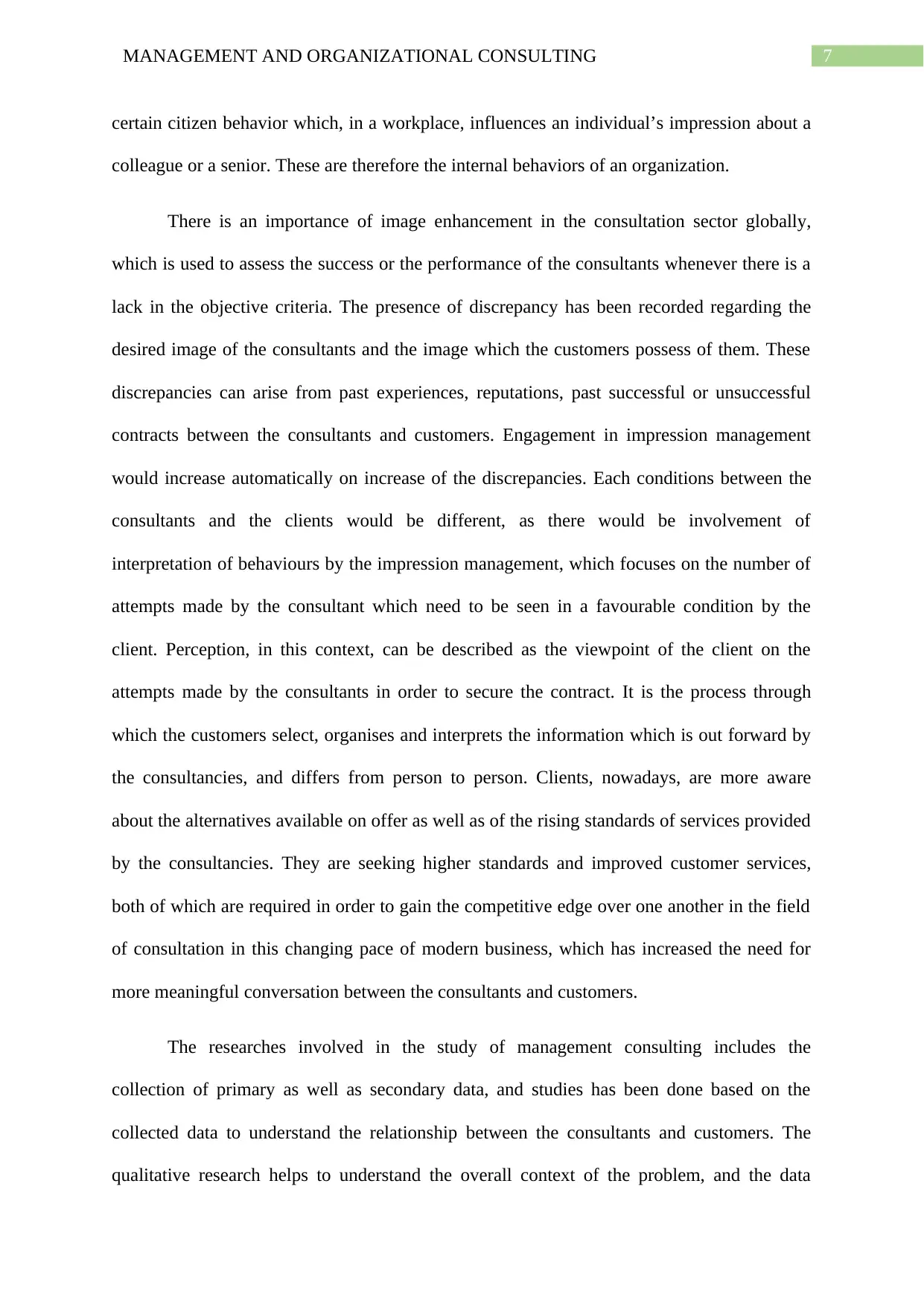
7MANAGEMENT AND ORGANIZATIONAL CONSULTING
certain citizen behavior which, in a workplace, influences an individual’s impression about a
colleague or a senior. These are therefore the internal behaviors of an organization.
There is an importance of image enhancement in the consultation sector globally,
which is used to assess the success or the performance of the consultants whenever there is a
lack in the objective criteria. The presence of discrepancy has been recorded regarding the
desired image of the consultants and the image which the customers possess of them. These
discrepancies can arise from past experiences, reputations, past successful or unsuccessful
contracts between the consultants and customers. Engagement in impression management
would increase automatically on increase of the discrepancies. Each conditions between the
consultants and the clients would be different, as there would be involvement of
interpretation of behaviours by the impression management, which focuses on the number of
attempts made by the consultant which need to be seen in a favourable condition by the
client. Perception, in this context, can be described as the viewpoint of the client on the
attempts made by the consultants in order to secure the contract. It is the process through
which the customers select, organises and interprets the information which is out forward by
the consultancies, and differs from person to person. Clients, nowadays, are more aware
about the alternatives available on offer as well as of the rising standards of services provided
by the consultancies. They are seeking higher standards and improved customer services,
both of which are required in order to gain the competitive edge over one another in the field
of consultation in this changing pace of modern business, which has increased the need for
more meaningful conversation between the consultants and customers.
The researches involved in the study of management consulting includes the
collection of primary as well as secondary data, and studies has been done based on the
collected data to understand the relationship between the consultants and customers. The
qualitative research helps to understand the overall context of the problem, and the data
certain citizen behavior which, in a workplace, influences an individual’s impression about a
colleague or a senior. These are therefore the internal behaviors of an organization.
There is an importance of image enhancement in the consultation sector globally,
which is used to assess the success or the performance of the consultants whenever there is a
lack in the objective criteria. The presence of discrepancy has been recorded regarding the
desired image of the consultants and the image which the customers possess of them. These
discrepancies can arise from past experiences, reputations, past successful or unsuccessful
contracts between the consultants and customers. Engagement in impression management
would increase automatically on increase of the discrepancies. Each conditions between the
consultants and the clients would be different, as there would be involvement of
interpretation of behaviours by the impression management, which focuses on the number of
attempts made by the consultant which need to be seen in a favourable condition by the
client. Perception, in this context, can be described as the viewpoint of the client on the
attempts made by the consultants in order to secure the contract. It is the process through
which the customers select, organises and interprets the information which is out forward by
the consultancies, and differs from person to person. Clients, nowadays, are more aware
about the alternatives available on offer as well as of the rising standards of services provided
by the consultancies. They are seeking higher standards and improved customer services,
both of which are required in order to gain the competitive edge over one another in the field
of consultation in this changing pace of modern business, which has increased the need for
more meaningful conversation between the consultants and customers.
The researches involved in the study of management consulting includes the
collection of primary as well as secondary data, and studies has been done based on the
collected data to understand the relationship between the consultants and customers. The
qualitative research helps to understand the overall context of the problem, and the data
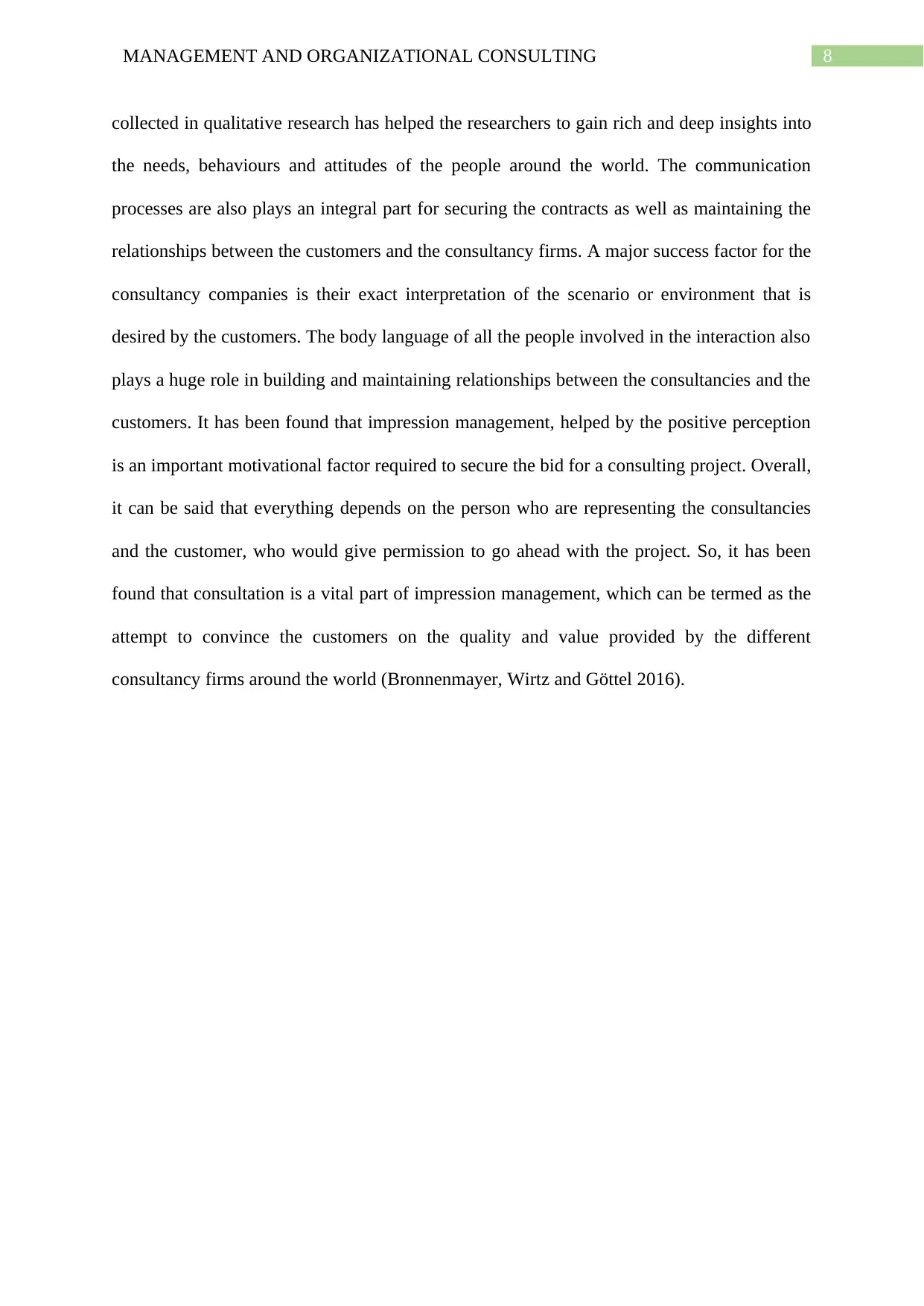
8MANAGEMENT AND ORGANIZATIONAL CONSULTING
collected in qualitative research has helped the researchers to gain rich and deep insights into
the needs, behaviours and attitudes of the people around the world. The communication
processes are also plays an integral part for securing the contracts as well as maintaining the
relationships between the customers and the consultancy firms. A major success factor for the
consultancy companies is their exact interpretation of the scenario or environment that is
desired by the customers. The body language of all the people involved in the interaction also
plays a huge role in building and maintaining relationships between the consultancies and the
customers. It has been found that impression management, helped by the positive perception
is an important motivational factor required to secure the bid for a consulting project. Overall,
it can be said that everything depends on the person who are representing the consultancies
and the customer, who would give permission to go ahead with the project. So, it has been
found that consultation is a vital part of impression management, which can be termed as the
attempt to convince the customers on the quality and value provided by the different
consultancy firms around the world (Bronnenmayer, Wirtz and Göttel 2016).
collected in qualitative research has helped the researchers to gain rich and deep insights into
the needs, behaviours and attitudes of the people around the world. The communication
processes are also plays an integral part for securing the contracts as well as maintaining the
relationships between the customers and the consultancy firms. A major success factor for the
consultancy companies is their exact interpretation of the scenario or environment that is
desired by the customers. The body language of all the people involved in the interaction also
plays a huge role in building and maintaining relationships between the consultancies and the
customers. It has been found that impression management, helped by the positive perception
is an important motivational factor required to secure the bid for a consulting project. Overall,
it can be said that everything depends on the person who are representing the consultancies
and the customer, who would give permission to go ahead with the project. So, it has been
found that consultation is a vital part of impression management, which can be termed as the
attempt to convince the customers on the quality and value provided by the different
consultancy firms around the world (Bronnenmayer, Wirtz and Göttel 2016).
⊘ This is a preview!⊘
Do you want full access?
Subscribe today to unlock all pages.

Trusted by 1+ million students worldwide
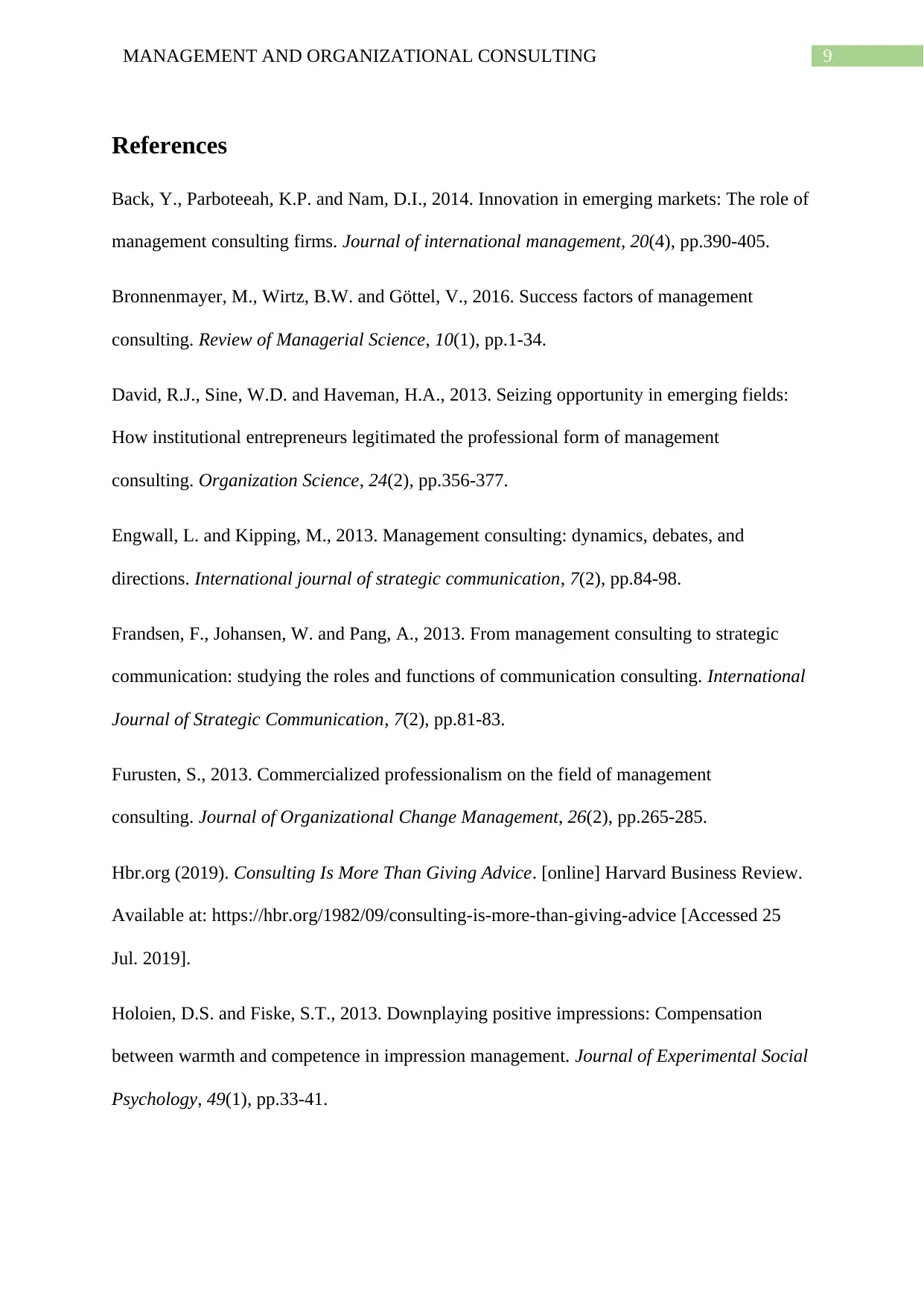
9MANAGEMENT AND ORGANIZATIONAL CONSULTING
References
Back, Y., Parboteeah, K.P. and Nam, D.I., 2014. Innovation in emerging markets: The role of
management consulting firms. Journal of international management, 20(4), pp.390-405.
Bronnenmayer, M., Wirtz, B.W. and Göttel, V., 2016. Success factors of management
consulting. Review of Managerial Science, 10(1), pp.1-34.
David, R.J., Sine, W.D. and Haveman, H.A., 2013. Seizing opportunity in emerging fields:
How institutional entrepreneurs legitimated the professional form of management
consulting. Organization Science, 24(2), pp.356-377.
Engwall, L. and Kipping, M., 2013. Management consulting: dynamics, debates, and
directions. International journal of strategic communication, 7(2), pp.84-98.
Frandsen, F., Johansen, W. and Pang, A., 2013. From management consulting to strategic
communication: studying the roles and functions of communication consulting. International
Journal of Strategic Communication, 7(2), pp.81-83.
Furusten, S., 2013. Commercialized professionalism on the field of management
consulting. Journal of Organizational Change Management, 26(2), pp.265-285.
Hbr.org (2019). Consulting Is More Than Giving Advice. [online] Harvard Business Review.
Available at: https://hbr.org/1982/09/consulting-is-more-than-giving-advice [Accessed 25
Jul. 2019].
Holoien, D.S. and Fiske, S.T., 2013. Downplaying positive impressions: Compensation
between warmth and competence in impression management. Journal of Experimental Social
Psychology, 49(1), pp.33-41.
References
Back, Y., Parboteeah, K.P. and Nam, D.I., 2014. Innovation in emerging markets: The role of
management consulting firms. Journal of international management, 20(4), pp.390-405.
Bronnenmayer, M., Wirtz, B.W. and Göttel, V., 2016. Success factors of management
consulting. Review of Managerial Science, 10(1), pp.1-34.
David, R.J., Sine, W.D. and Haveman, H.A., 2013. Seizing opportunity in emerging fields:
How institutional entrepreneurs legitimated the professional form of management
consulting. Organization Science, 24(2), pp.356-377.
Engwall, L. and Kipping, M., 2013. Management consulting: dynamics, debates, and
directions. International journal of strategic communication, 7(2), pp.84-98.
Frandsen, F., Johansen, W. and Pang, A., 2013. From management consulting to strategic
communication: studying the roles and functions of communication consulting. International
Journal of Strategic Communication, 7(2), pp.81-83.
Furusten, S., 2013. Commercialized professionalism on the field of management
consulting. Journal of Organizational Change Management, 26(2), pp.265-285.
Hbr.org (2019). Consulting Is More Than Giving Advice. [online] Harvard Business Review.
Available at: https://hbr.org/1982/09/consulting-is-more-than-giving-advice [Accessed 25
Jul. 2019].
Holoien, D.S. and Fiske, S.T., 2013. Downplaying positive impressions: Compensation
between warmth and competence in impression management. Journal of Experimental Social
Psychology, 49(1), pp.33-41.
Paraphrase This Document
Need a fresh take? Get an instant paraphrase of this document with our AI Paraphraser
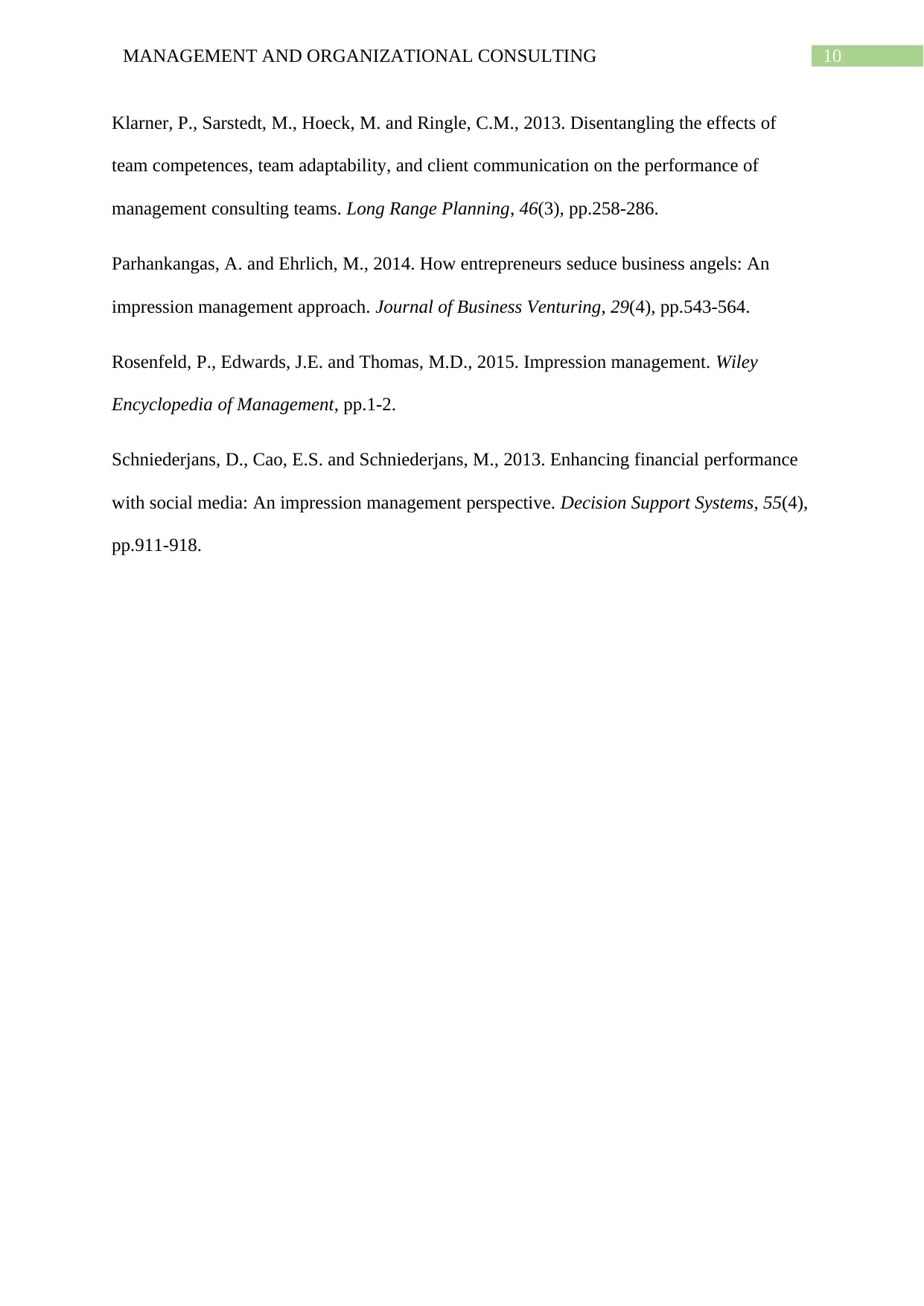
10MANAGEMENT AND ORGANIZATIONAL CONSULTING
Klarner, P., Sarstedt, M., Hoeck, M. and Ringle, C.M., 2013. Disentangling the effects of
team competences, team adaptability, and client communication on the performance of
management consulting teams. Long Range Planning, 46(3), pp.258-286.
Parhankangas, A. and Ehrlich, M., 2014. How entrepreneurs seduce business angels: An
impression management approach. Journal of Business Venturing, 29(4), pp.543-564.
Rosenfeld, P., Edwards, J.E. and Thomas, M.D., 2015. Impression management. Wiley
Encyclopedia of Management, pp.1-2.
Schniederjans, D., Cao, E.S. and Schniederjans, M., 2013. Enhancing financial performance
with social media: An impression management perspective. Decision Support Systems, 55(4),
pp.911-918.
Klarner, P., Sarstedt, M., Hoeck, M. and Ringle, C.M., 2013. Disentangling the effects of
team competences, team adaptability, and client communication on the performance of
management consulting teams. Long Range Planning, 46(3), pp.258-286.
Parhankangas, A. and Ehrlich, M., 2014. How entrepreneurs seduce business angels: An
impression management approach. Journal of Business Venturing, 29(4), pp.543-564.
Rosenfeld, P., Edwards, J.E. and Thomas, M.D., 2015. Impression management. Wiley
Encyclopedia of Management, pp.1-2.
Schniederjans, D., Cao, E.S. and Schniederjans, M., 2013. Enhancing financial performance
with social media: An impression management perspective. Decision Support Systems, 55(4),
pp.911-918.
1 out of 11
Related Documents
Your All-in-One AI-Powered Toolkit for Academic Success.
+13062052269
info@desklib.com
Available 24*7 on WhatsApp / Email
![[object Object]](/_next/static/media/star-bottom.7253800d.svg)
Unlock your academic potential
Copyright © 2020–2025 A2Z Services. All Rights Reserved. Developed and managed by ZUCOL.


